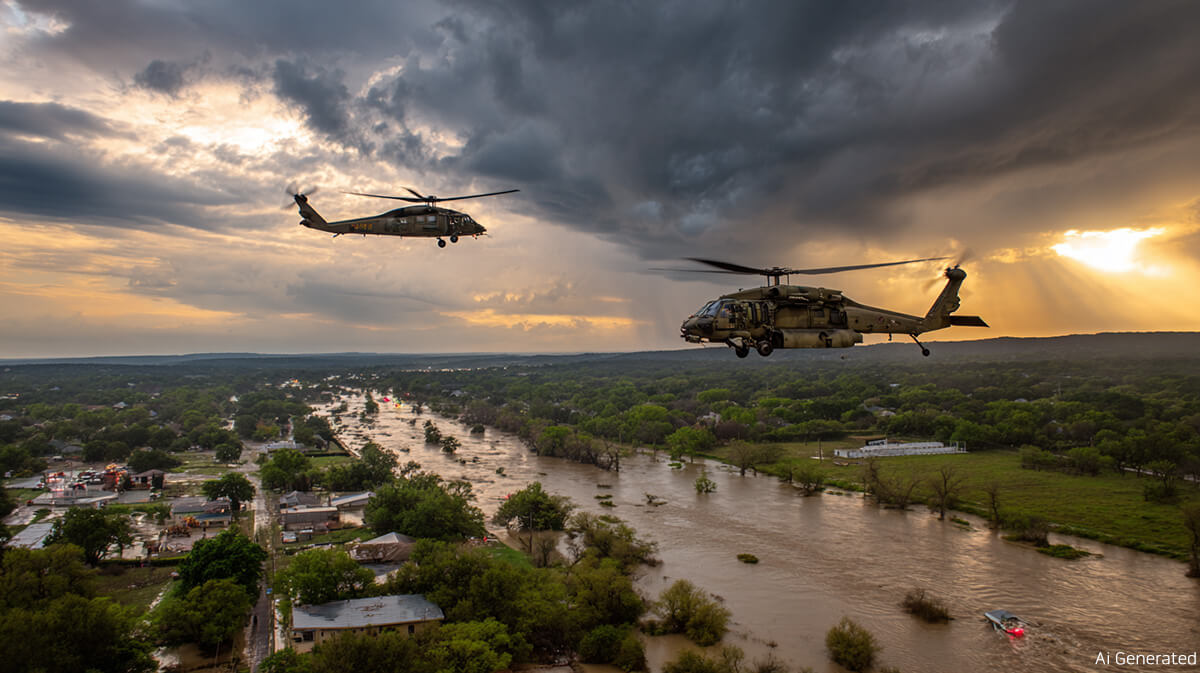Fast-moving floodwaters tore through Texas Hill Country early Friday morning, leaving a trail of destruction along the Guadalupe River that has claimed at least 43 lives and sparked urgent search efforts for 27 girls still missing from a Christian summer camp.
The devastating floods struck in the pre-dawn hours of July 4th, when the Guadalupe River rose an unprecedented 26 feet in just 45 minutes. The sudden surge overwhelmed communities in Kerr County and surrounding areas, washing away homes, vehicles, and devastating Camp Mystic, a century-old Christian girls' retreat.
Among the confirmed dead are 28 adults and 15 children, according to Kerr County Sheriff Larry Leitha. Seventeen of those killed, including five children, have yet to be identified. Officials say the death toll is expected to rise as search and recovery operations continue across the flood zone.
Camp Mystic Becomes Center of Tragedy
Camp Mystic, which hosted approximately 750 girls at the time of the flooding, has become the focal point of the rescue operation. The camp, located along a bend in the Guadalupe River near Hunt, Texas, sustained what officials described as "catastrophic floods" that knocked out power, water, and communications.
Twenty-seven girls from the camp remain unaccounted for, though officials stressed they are operating under the assumption that missing persons are still alive. "My instruction to every state agency involved in this is to assume everybody who is missing is alive," Governor Greg Abbott said Saturday. "There's a need for speed, not just every hour, every minute counts."
The camp sent desperate messages to families on Friday, explaining that "the highway was washed away so we are struggling to get more help." Texas Game Wardens eventually reached the facility Friday evening and began evacuating campers by helicopter.
Inside damaged cabins at the camp, mud lines on walls showed floodwaters reached at least six feet high. Mattresses, bed frames, and personal belongings lay scattered and caked with mud. Some buildings had broken windows, while others sustained missing walls from the force of the water.
Dramatic Rescues and Heroic Stories
More than 850 people have been rescued from the flood zone, with 167 evacuated by helicopter alone according to Major General Thomas Suelzer. Stories of survival and sacrifice have begun emerging from the devastation.
One young woman was rescued after being carried 12 miles downstream by raging floodwaters, later found clinging to tree branches. In Ingram, Texas, Julian Ryan died saving his fiancée and their children, severing an artery in his arm while punching out a window to evacuate his family as waters rushed into their home.
Thirteen-year-old camper Elinor Lester described being evacuated by helicopter from elevated ground at her camp, while younger campers in cabins along the riverbank were among the first to be flooded.
Weather Service Forecasting Under Scrutiny
The flooding has sparked debate over weather forecasting accuracy and emergency preparedness. Nim Kidd, chief of the Texas Division of Emergency Management, said the National Weather Service had predicted 4 to 8 inches of rain for the area, but "the amount of rain that fell in this specific location was never in any of those forecasts."
The National Weather Service had issued a flood watch Thursday afternoon predicting up to 7 inches of rainfall, but radar estimates showed as much as 12 inches fell in parts of the region. The Guadalupe River gauge at Hunt recorded a 22-foot rise in just two hours before becoming completely submerged and failing.
Kerr County Judge Rob Kelly acknowledged the area "does not have a warning system" and said authorities were shocked by the ferocity of the floods. "We had no reason to believe that this was gonna be anything like what's happened here. None whatsoever," Kelly told reporters.
However, meteorologists defended their forecasting efforts. The National Weather Service began issuing hazardous flood outlooks Thursday morning and upgraded to flood warnings overnight, impacting 30,000 people. Tom Fahy, legislative director for the NWS employees' union, said the forecast offices had "adequate staffing and resources" to issue timely warnings.
Federal Response and Political Implications
President Donald Trump approved Governor Abbott's request for a federal disaster declaration, unlocking federal aid for affected counties. Homeland Security Secretary Kristi Noem deployed U.S. Coast Guard and FEMA resources to assist with search operations.
"Our Brave First Responders are on site doing what they do best," Trump wrote on Truth Social, adding that Noem would soon be on the ground in Texas.
The disaster has raised questions about recent personnel cuts at the National Weather Service under the Trump administration. The Austin-San Antonio NWS office is currently operating without a warning coordination meteorologist, a key position that serves as a direct link between forecasters and emergency managers. This vacancy resulted from early retirement incentives offered as part of federal budget reduction efforts.
Critics, including former NOAA director Rick Spinrad, warned that staff cuts would inevitably degrade weather service capabilities, though current officials maintain they had adequate resources for this event.
Historic Flooding Event
The flooding reached the second-highest level on record for the Guadalupe River at Hunt, exceeding the infamous 1987 flood that long served as a benchmark for the region. Meteorologists described the event as a "rain bomb" typical in areas emerging from multi-year droughts.
The extreme rainfall resulted from a combination of Gulf of Mexico moisture and a slow-moving storm system that created "training" thunderstorms – downpours that repeatedly regenerated over the same area. A mesoscale convective vortex, described as a weak atmospheric swirl about 20 to 30 miles across, fed the storms with tropical moisture like a pinwheel.
Ongoing Search Operations
Search and rescue efforts continue with multiple agencies deploying helicopters, rescue boats, and ground teams across the affected area. Dogs are assisting in searching riverbanks where people may be missing, while crews use drones and other technology to cover vast areas.
Texas officials say they will continue operations until every missing person is found. Lieutenant Governor Dan Patrick expressed hope that some of those unaccounted for "could be in a tree, they could be out of communication."
Flash flood warnings remained in effect Saturday as additional rainfall threatened the region. The National Weather Service warned of a "particularly dangerous situation" with the potential for renewed flooding.
The flooding has devastated a region known for its scenic beauty, historic towns, and summer camps that have served generations of Texas families. Heart O' the Hills, another girls' camp in the area, confirmed that co-owner Jane Ragsdale died in the flood, though no campers were present as the facility was between sessions.
Abbott expanded the state disaster declaration Saturday to include additional counties impacted by the flooding, including Travis County where four additional fatalities were confirmed. Local funeral homes reported being completely overwhelmed by the scope of the tragedy.
As the search continues and floodwaters recede, the full extent of this historic disaster is still being assessed. Officials stress that the immediate priority remains finding survivors and providing assistance to affected families and communities.
Sources: Al Jazeera, The Guardian, AP News, Fox News, CNN, NPR, Reuters, CBS News, Texas Tribune, Dallas Morning News, Houston Chronicle, ABC News, Washington Post, KXAN Austin, AccuWeather, Common Dreams






